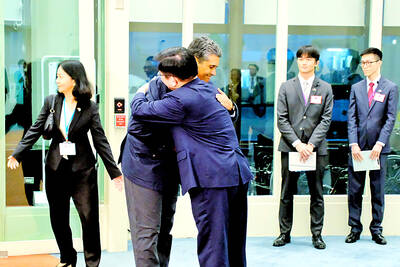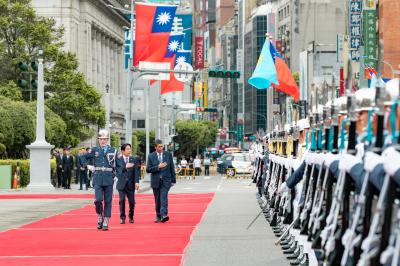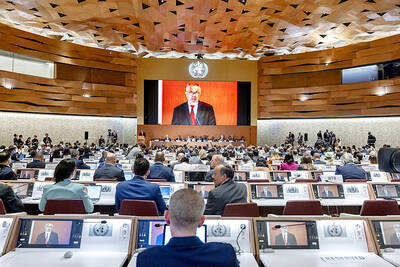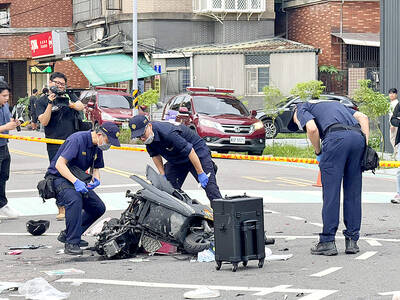The Environmental Protection Administration (EPA) announced that it introduced an Air Quality Index on Thursday, the most up-to-date standard on air quality.
Before the introduction of the PM2.5 index in October 2014, the nation had previously operated the Pollutant Standard Index, which gauged air quality based on how particulate matter of about 10 micron (PM10), carbon monoxide, sulfur dioxide, nitrogen dioxide and ground-level ozone affected the human body.
As more people became concerned about PM2.5 density, the agency started losing sight of the other pollutants, it said, adding that Taiwan is following the example of other nations and combining all pollutants under one index.
The new index is separated into six levels, with green being the lowest at zero to 50 micrograms per cubic meter of air (mcg/m3) per hour, yellow representing normal levels at 51 to 100mcg/m3 per hour, orange representing unhealthy for sensitive groups at 101 to 150mcg/m3 per hour, red representing unhealthy levels for all at 150 to 200mcg/m3 per hour, purple representing very unhealthy at 201 to 300mcg/m3 per hour and maroon, at 301 to 500mcg/m3 per hour, considered hazardous, the agency said.
The most severe of all five kinds of pollutants would be selected to represent that day’s pollutant level, it said.
According to the new scale, the previously “purple” levels of PM2.5 would now be considered red, it said, adding that this was not a relaxation of standards, but rather the use an index that highlights the dangers of pollutants aside from PM2.5.
The agency is mulling measures to step up the control of air pollutants based on the season, including offering factories discounts on their air pollution taxes if they are willing to emit less pollutants during fall and winter.
The emissions decrease would start once local area PM2.5 pollutants reached 35mcg/m3 per hour, it said, adding that it would force emission decreases should pollutants reach 54mcg/m3 per hour.
It said it was also looking into the possibility of reinforcing demands on factories to prioritize vehicles that meet the agency’s fourth-stage emission standards.
The fourth stage standards were implemented in 2006 and constrain the amount emissions of large trucks and cars, while including additional examinations for pollutants such as non-methane organic gases and formaldehyde.
The agency said it would also encourage the use of public transportation and would be starting a system where individuals would be awarded points for using environmentally friendly transportation during fall and winter, adding that the points can then be exchanged for gifts.

Palauan President Surangel Whipps Jr arrived in Taiwan last night to kick off his first visit to the country since beginning his second term earlier this year. After arriving at Taoyuan International Airport at around 6:30 pm, Whipps and his delegation were welcomed by Minister of Foreign Affairs Lin Chia-lung (林佳龍). Speaking to gathered media, the Palauan leader said he was excited and honored to be back in Taiwan on his first state visit to Taiwan since he was sworn in this January. Among those traveling with Whipps is Minister of State Gustav N. Aitaro, Public Infrastructure

President William Lai (賴清德) yesterday thanked Palau for its continued support of Taiwan's international participation, as Taipei was once again excluded from the World Health Assembly (WHA) currently taking place in Switzerland. "Palau has never stopped voicing support for Taiwan" in the UN General Assembly, the WHO and other UN-affiliated agencies, Lai said during a bilateral meeting with visiting Palau President Surangel Whipps Jr. "We have been profoundly touched by these endorsements," Lai said, praising the Pacific island nation's firm support as "courageous." Lai's remarks came as Taiwan was excluded for the ninth consecutive year from the WHA, which is being held in

RESOLUTIONS DEBATE: Taiwan’s allies said that UN and WHA resolutions cited by China and other nations ‘do not determine Taiwan’s participation in WHO activities’ A proposal to invite Taiwan to this year’s World Health Assembly (WHA) was rejected on Monday, resulting in Taipei’s absence from the annual meeting for a ninth consecutive year, although partners spoke up for Taiwan’s participation at the first day of the meeting. The first agenda item after the opening was a “two-on-two debate” on a proposal to invite Taiwan to participate at the WHA as an observer. Similar to previous years, two countries made statements in favor of the proposal, while two others expressed their opposition. Philippine Secretary of Health Teodoro Herbosa, president of the 78th WHA, accepted the WHA General Committee’s

At least three people died and more than a dozen were injured yesterday afternoon when a vehicle struck a group of pedestrians in New Taipei City’s Sansia District (三峽). The incident happened at about 4pm when a car rammed into pedestrians at an intersection near Bei Da Elementary School. Witnesses said the sedan, being driven at a high speed, ran a red light, knocking scooters out of the way and hitting students crossing the road before careening into a median near the intersection of Guocheng and Guoguang streets. The incident resulted in three deaths and 13 injuries, including the driver, a 78-year-old man